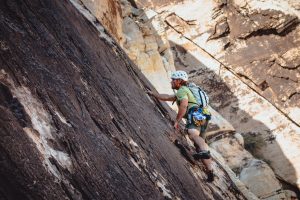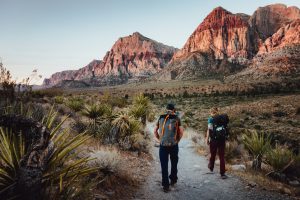2020 Mammut Scholarship | Dominic Rickicki

Myself leading “Left Out” during the movement exam – Photo: Kory Markel
In the fall of 2020 I participated in an Advanced Rock Guide Course in Red Rocks. This trip to Red Rocks was my first time to visit the climbing area, which made for a much welcomed course experience where I needed to utilize a lot of outside resources for route beta and guiding considerations. Previous to this course/exam I had completed the RGC and AGC, for both of those courses I went to destinations I am quite familiar with and guide in quite often. This has resulted in overwhelming feedback that I should participate in a course at a location less familiar to me.
The first challenge I had to face climbing at Red Rocks was the oppressive heat the area was experiencing at the time. I went out to Vegas two weeks ahead of the course to get to know the area, and from the time I showed up to the day I left the temps in Las Vegas never dropped below 90 degrees. This meant climbing a lot in the shade and learning a whole bunch about caring for yourself as a guide as well as caring for clients.

Sarah Janin setting off on “Slot Machine” during the Aspirant Exam – Photo: Dominic Rickicki
Due to Covid-19 the AMGA has moved to courses adopting “pods” for instructors and students so that a large group is not potentially spreading the virus. I was happy to have Mike Soucy as the instructor for my pod, Mike was also an instructor of mine for the AGC and I really respect him as a guide and instructor. Given the heat we were all dealing with I felt I learned so much about client care in harsh environments just by watching how well Mike kept us comfortable during course days. This also applies to how well he handled the challenges of teaching a course in the midst of a pandemic. I feel that there is a bit of guiding that gets lost behind the stress we all put on technical skills, and that bit is how important client care is. Methods to improve client care have been integral parts of every course I have taken, but I have found that beyond what we are taught verbally, so much can be learned by watching how the instructors treat you as participants in their course. Mike exemplified this in his emails, morning meeting contributions and planning around when the day would be hottest. I look forward to the coming rock guiding season when I can use these skills to help improve the quality of product I provide for my own clients.
The ARGC is the first advanced course I have taken, and one thing I found incredibly helpful about this course was that a lot of it was based on feedback given while you are in the driver’s seat. Looking back on past courses, the biggest lessons I have learned have come from feedback I got while I was the leader. Since I had never been to Red Rocks before I was often on-sighting during course/exam days, an aspect of guiding which I feel I am constantly working to improve and find more flow within.

Jason Antin getting his cardio in so he doesn’t miss any lessons at the belay station. – Photo: Dominic Rickicki
During the last year I took the AGC and I spent a full season guiding in the Cascades on Rainier and Baker. On top of that I also have guided a lot in RMNP, especially Long’s Peak. What this had resulted in during my ARGC was a lot of haste while onsight guiding, in an environment that lends itself to reducing the haste a bit in favor of security. While guiding the descent on Dark Shadows I decided to lead a short 5.3 section without a belay, in favor of just placing some pieces to “shorten the rope.” Upon reflection of this Mike and I both agreed that given the rock guide nature of the area, the stable weather, and the shorter approaches, I could have taken a belay there for increased security without much of a time penalty. While the technique I used may have been applicable in some situations in the alpine, I do need to work on switching my brain to rock guide mode and slowing it down a bit when appropriate. Given the increased security this allows for, I happily take the feedback and will continue to work on it as I move forward.
Despite some challenges that this course provided, I did go into it feeling good about my foundation of knowledge and the work I had put in leading up to the course. I felt comfortable during my movement exam and during my rescue drill I was able to take a deep breath and perform efficiently. For the guiding exam days I felt the experience I had in the field aided in my ability to operate under stress and error correct where needed. I still have a lot to work on, but I am happy that I was able to go into this course confident and open to learning without a heavy amount of stress holding me down.

Meg Yingling belaying Mike Soucy on “Lotta Balls” during the instructor demo. – Photo: Dominic Rickicki
I have a lot of people to offer thanks to for the knowledge and feedback they have shared with me throughout this process, but I will mention just one piece of advice that was given to me by Silas Rossi on my RGC, and that was to be patient throughout this process, if you don’t get into a course first try or it takes you a year or more to afford the exam you want to take it will likely end up working out more for your benefit in the end. I know that when I first started down the AMGA track I wanted to get a certification so bad, even to this day it plagues me to just want that little bit of accreditation next to my name. I thought I would just fly through the rock program in no time and have that cert with me forever, instead I took two years between my RGC and ARGC. I believe that if I had tried to rush it any more than that I wouldn’t have had the base of knowledge I have now and the exam may have gone differently for me. Although that pin sounds nice, I am in love with this process and whenever I feel anxious about rushing through it I can remember that a little extra time in the process isn’t always a bad thing.

Mike Soucy and Sarah Janin hiking into Pine Creek early to beat the heat. – Photo: Dominic Rickicki
Lastly I would like to thank Mammut so much for this scholarship. Knowing that folks support you out there, enough so to provide money for your coursework, is incredibly encouraging to continue on this path and work hard towards being the best you can be. The guiding life is so unconventional and it’s hard at times to not question why you’re doing it, but the next time I go down that path I know I can look back on support like this to help me continue with my goals.












